CYPRIOT ROOTS
Cyprus meets Greece in the Cape Town CBD
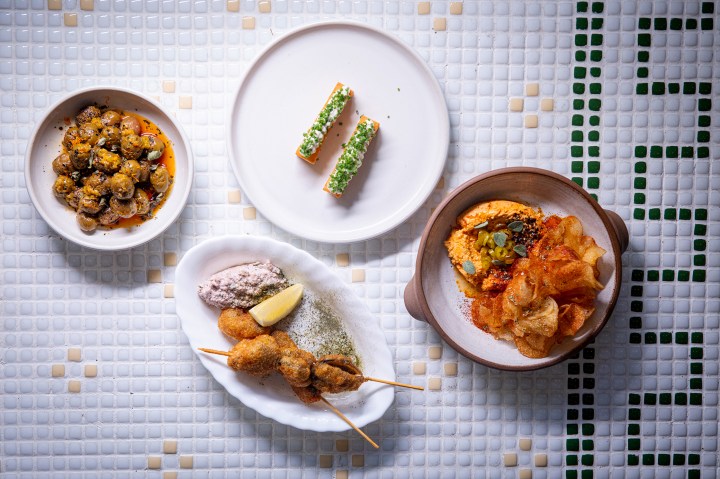
At Ouzeri, chef Nic Charalambous is tapping into his Greek-Cypriot roots to honour the dishes he grew up with while giving them a modern twist.
With a passion born in his grandmother’s kitchen from the tender age of 10, young Nic Charalambous went on to study at Silwood. Even then, in 2013, the ideas were forming to combine the traditional food of Greece and Cyprus with contemporary cuisine. After a stint in Dubai, and lockdown percolation, Charalambous returned to South Africa to follow his dream.
A friend and I, bonded by a love for food and for frequently spilling it down our fronts, especially when wearing something new or white or both, are busy working on a project. Through various restaurant visits we are building up and planning excursions that will begin with a spectacular starter at one place, followed by a main course somewhere else, and finally a dessert at a third stop. A show before (the ballet matinee for example), will complement our brilliant night out.
We have the initial contenders for starters (pork bao buns at Bao Down) and mains (beetroot risotto with prawn tartare at Riva, if it’s on the daily-changing menu), and last Saturday I discovered the qualifying dessert: Yoghurt cake with visino (sour cherries) and Jersey yoghurt, at the newly opened (as in a mere two weeks now) Ouzeri in Wale Street, Cape Town city centre.
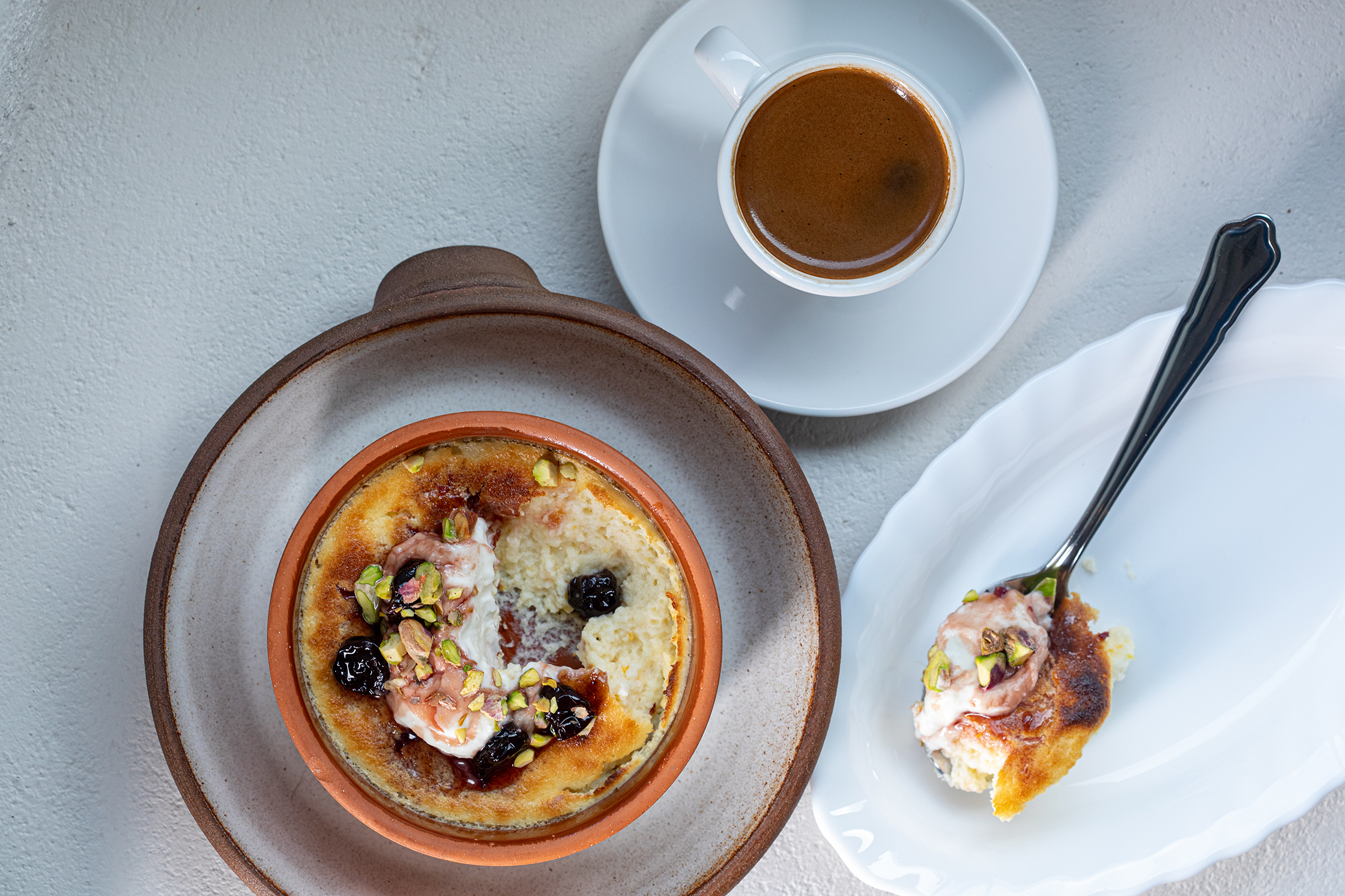
Yoghurt cake with visino and Jersey yoghurt. (Photo: Jan Ras Photography)
It was the finishing touch on a meal that jokingly began as “one of everything please”, except the deep fried mussels because damn allergy, that suddenly turned serious as we did indeed work through almost the entire menu. Zero regrets.
Ouzeri, which opened on June 16, 2022, is “the trendy-meets-traditional Cypriot-Greek restaurant” where Nic Charalambous is the executive chef and owner. He describes his dishes as versions of the food he grew up eating: “The menu is in many ways my interpretation of the food and culture of my Cypriot heritage.” I first met him late 2017 when he was exploring this at Love Thy Neighbour in Bree Street. We reminisced for a bit, about some of the dishes then and now, and his approach to wines. Then he brought me up to speed with what he’s been doing since then.
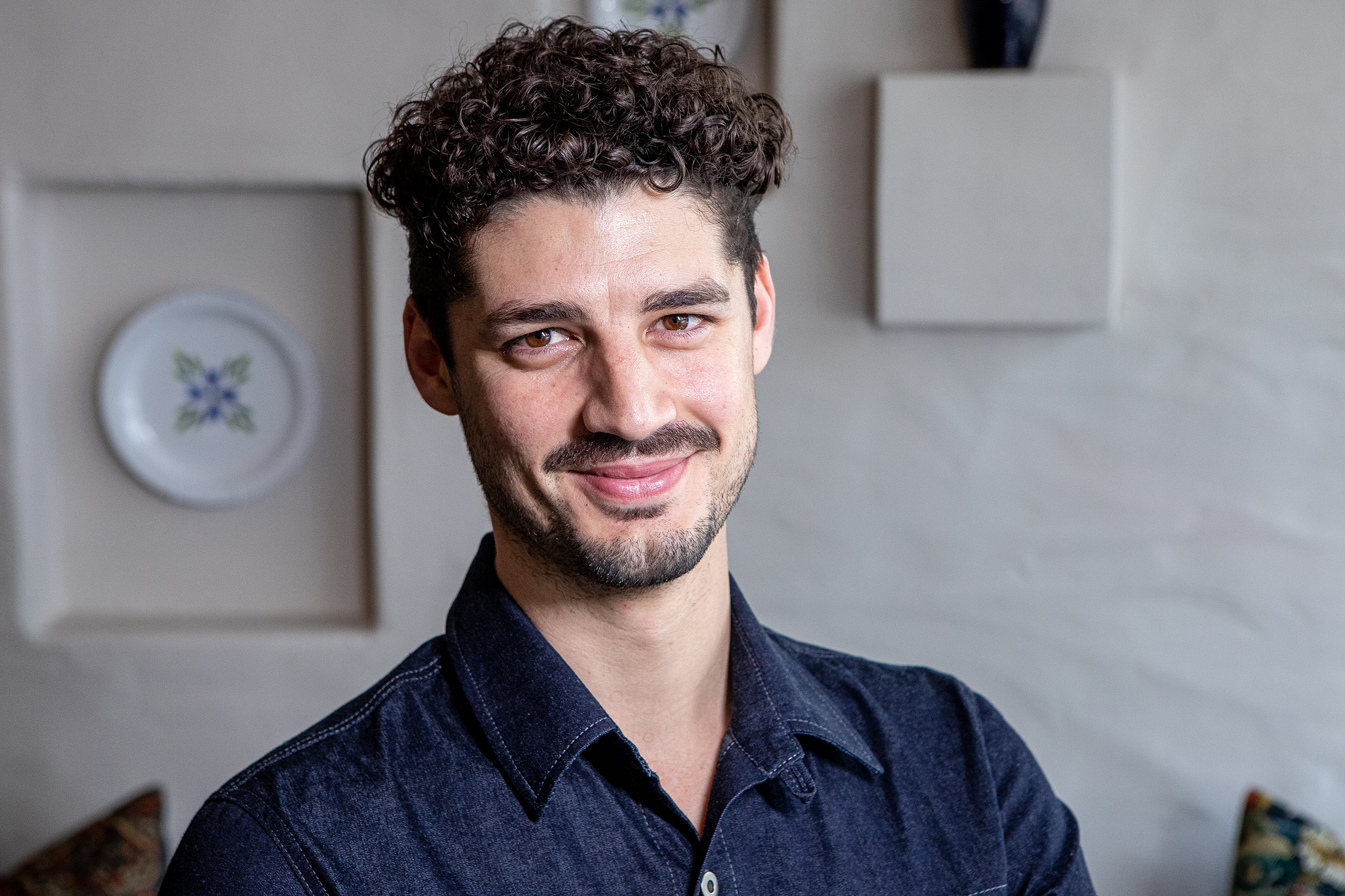
Owner and chef Nic Charalambous. (Photo: Jan Ras Photography)
Charalambous left Love Thy Neighbour fairly soon after that delicious day, and taught for a year at SA Chefs Academy. Then he got offered a job in Dubai, by Natasha Sideris of The Tashas Group, to open and head up her Athenian-inspired, Avli by tashas. It was never going to be forever, and while in the early days of lockdown with nothing but time on his hands, Charalambous got to thinking. “I knew I wanted to do something, for a while. I had the concept and the idea. I think I was about a year in Dubai when I started working on stuff, business wise and concept wise.”
When Charalambous returned to South Africa in 2020, it was with the plan to run Ouzeri as a pop-up, thinking a lot of spaces would be available. It didn’t quite turn out that way but he still managed to do pop-ups at Leo’s Wine Bar and Athletic Club & Social. And in between, Feast at Home boxes, which he said were annoying but successful, with similar food to what he’s making now, but more “homey”. Goodness, remember those lockdown home deliveries? It feels like a lifetime ago.
The plan was to get his name out there and make connections with people. The boxes were very personal. “I only did 20 a day, on Fridays and Saturdays, with a music playlist, recipe cards, candles, flowers…” said Charalambous.
From early 2021, he began looking at spaces and places to give Ouzeri a permanent home including its current location in Wale Street – well positioned next door to another popular joint, Honest Chocolate, and a short walk to food-heavy Bree Street. Competition? Perhaps. But it all adds to the delightfully dense mix of eating choices in the area.
Charalambous didn’t nab the premises immediately, but it was clearly meant to be because they came back to him in December 2021. “I always liked it, and I could see it as it is now,” he said. “I hadn’t even signed the lease but I was already talking to Yaniv Chen of Master Studio.” In January 2022, the designing and planning began.
As with the food, the interior merges the sophisticated with the nostalgic and classic with contemporary, drawing inspiration from regions across Cyprus and Greece.
“For this project we delved into the history of Cypriot artistic heritage, which was influenced by many civilisations. Notably the Byzantines, Venetians and Ottomans creating the woven textiles, tapestries and soft architecture seen throughout the island,” said Chen of the project. The walls are white plaster with soft edges and arched wall niches; the textured tapestries and printed cushions are reminiscent of a traditional old Cypriot café. I’ve not been to such places but it feels and looks the way I imagine them.
For the food, Charalambous has turned to childhood memories, family recipes and dishes discovered through his travels across the region. The first item is taramasalata and it’s not like the artificially coloured pink stuff with which you’re probably familiar.
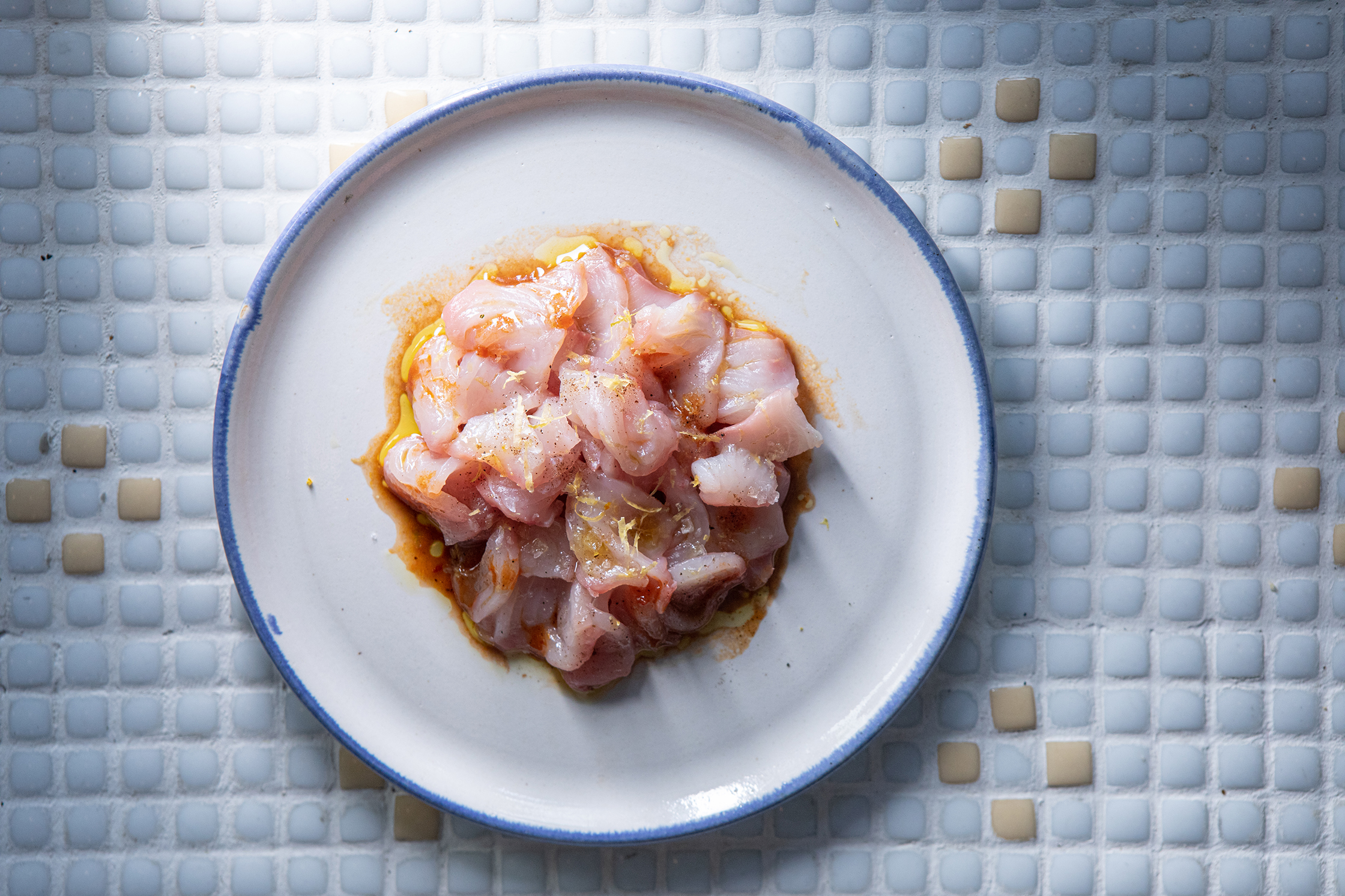
Pastourma cured yellowtail with fermented red pepper. (Photo: Jan Ras Photography)
“I always loved tarama and always wanted it on the menu but I didn’t want to have it just like a dip,” said Charalambous.
Each dish is referenced to its place of origin, in this case Sifnos, one of the Cyclades islands on the Aegean side of Greece, famous for its revithia chickpeas and its tarama. “And I love panisse (chickpea fries), which is a southern French dish, so I put the two together. That was how I wanted to serve it. Part of the way I wanted the menu to be designed, is that you get some very contemporary takes but at the same time some very traditional elements,” said Charalambous. It’s an unexpected contrast of textures and temperatures, and extremely moreish.
He will always do some kind of warm olives, or roasted, said Charalambous, because that’s such a nostalgic thing for him, something his family would eat every Sunday. At the moment these are green ones with a paprika oil, coriander seeds and citrus. In Cyprus, green olives – tsakistes – are bashed and marinated; here, cooking them over the coals – used for several dishes at the restaurant – takes the edge off.
Kalamaki – which means skewered – lamb sweetbreads (tourkakia) are served with potato bread, tahini yoghurt and sumac shallots. The mussels I could not have are already clearly a popular dish. The people at the next table ordered them, then ordered two more portions and I respect that decision. With small plates there’s nothing wrong with having more of what you fancy, something which I intend to fully embrace. “They’re deep fried. You can’t go wrong with deep fried,” said Charalambous, with a smile. He’s not wrong.
Eliopita literally translates to olive bread, with its origins in Cyprus. Everyone does it their own way, said Charalambous, and he has his. “The olive mixture inside the dough is the traditional part – my grandmother’s recipe.” Pitted olives, dried and salted, with a really intense taste, are mixed with dried mint, fresh mint and spring onion. Folded into the mixture and baked as a bun when you order it, it comes with roasted garlic that you squeeze out like toothpaste, and anchovies for an umami flavour bomb. More anchovies please, I said to Charalambous.
The tirokafteri is very traditional whipped feta with crisps, from Florina, a region in the north known for its peppers; and pastourma cured yellowtail with fermented red pepper is definitely a contemporary take. “I just wanted a raw fish dish on the menu,” explained Charalambous. “Pastourma, a spicy sausage, is one of my favourite things to eat in Cyprus.”
Using elements of the dry cure for the sausage, the dish includes days and hours of fermenting and curing, and while several of those ingredients are powerful, nothing dominates the fish, resulting in a clean, delicate and all balanced dish.
Then there is the halloumi, folded like a calzone with mint inside, excellent olive oil, a lemon wedge, and cucumber with tashi (a tahini dip) on the side. Cucumbers are so weird. I love them in many forms but never at home for some reason where I make my own salad and then eat around them. Go figure. These sticks are delicious and clearly some kind of magical cucumber.

Eliopita, halloumi, cucumber and tashi. (Photo: Jan Ras Photography)
The halloumi and the yoghurt are supplied by Cream Of The Crop, made by Maria van Zyl, soon to be Charalambous’s sister-in-law when he gets married on Cyprus in September. Van Zyl studied at the university of gastronomic sciences in northern Italy and it was there her true passion for dairy and cheese began to grow. “We travelled through France and Italy meeting producers, farmers and cheese makers that really shaped the way I saw dairy farming. After graduation I came back to South Africa and started making cultured butter, from there I branched out into other products,” she said.
“For Ouzeri I make our double thick yoghurt, which takes three days to make. Once the yoghurt has set and chilled, we scoop the soft delicate curds into a cloth to be hung for a day to remove all the whey. This gives the yoghurt a very thick and creamy texture, without adding thickening agents to achieve this texture.
“When Nic asked me to make halloumi, I said yes! And then I had to get practising. I’d drop off samples for him to try and slowly we tweaked the recipe to find the perfect texture, size and flavour. We use fresh mint in the centre of the halloumi as well as our favourite Khoisan sea salt.
“We shape the halloumi in the traditional Cypriot style, preserving traditional cheese making methods and techniques. The mint is said to aid in the preservation of the halloumi, as traditionally it will be preserved in a brine solution at room temperature. It also gives a wonderful fresh flavour.
“In spring I’ll be using a combination of goat and cow milk for a special spring halloumi, much closer in flavour to the traditional Cypriot halloumi. We are trialling out a feta for Ouzeri too.”
The location of Van Zyl’s cows was of great interest to me. Where exactly are they, I wanted to know, and what of the two cows promised for the exclusive use of Ouzeri?
“Our cows! My parents recently moved to a beautiful farm in Bo-Piketberg where I will keep my cows,” said Van Zyl. “I will set up Cream Of The Crop, and build my dairy and cheese cave there. We currently source our milk from Camphill on the West Coast as their farming methods and care of their animals aligns with our values. We are very excited to have our own cows.”
Van Zyl said she hopes to work with Charalambous to make dairy products just for Ouzeri from their own cows that she will look after. “This way we will ensure a closed loop and he will be able to get involved in the process and know the true source and quality of his ingredients. This will also benefit us as the initial expenses of setting up a diary are very high.”
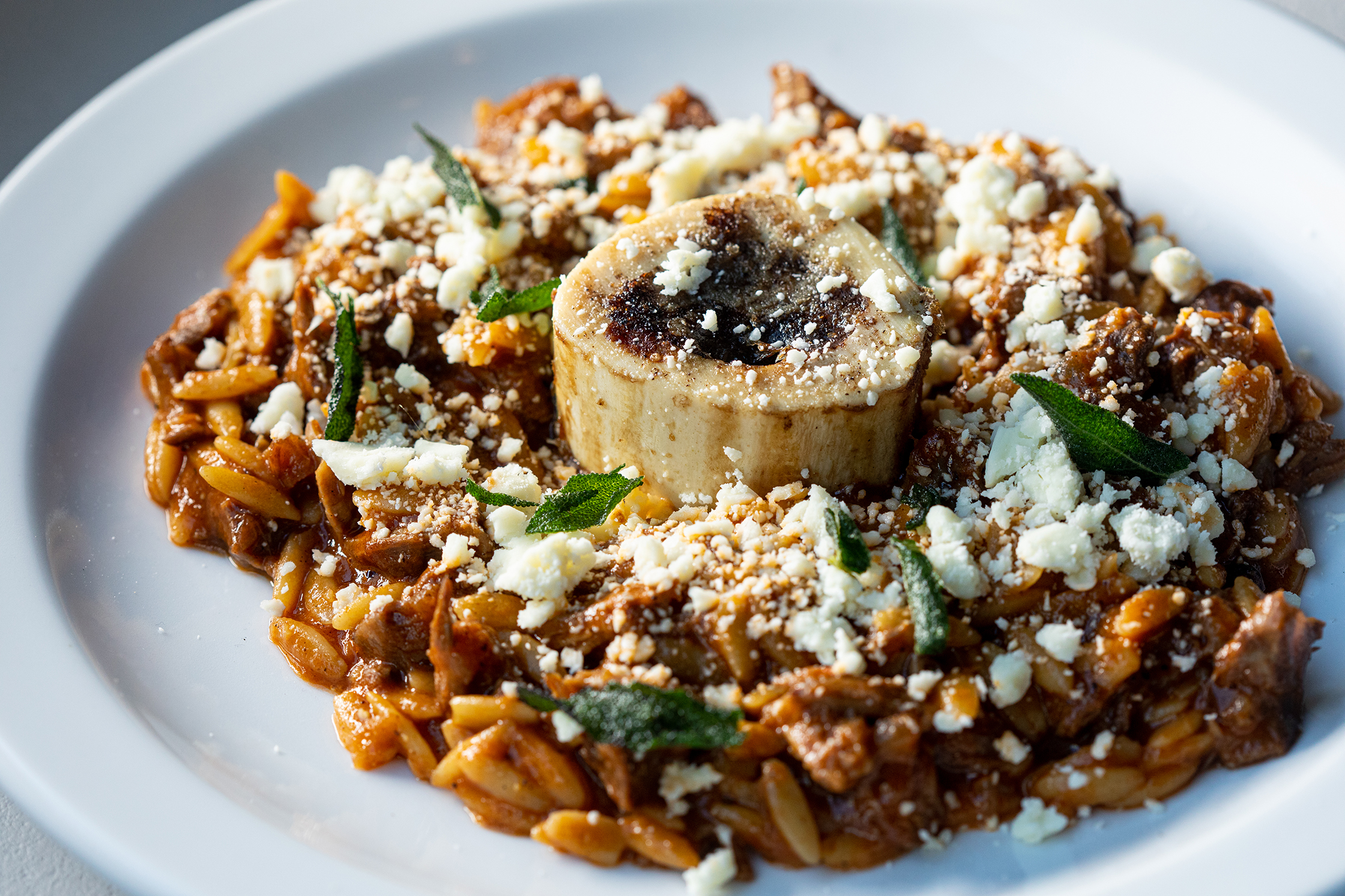
Beef shin youvetsi with roasted bone marrow and goat’s milk cheese. (Photo: Jan Ras Photography)
The last savoury dish on the lunch menu – which is entirely small plates for sharing – is manti from Macedonia. “They are very Turkish or very Balkan or very Armenian – it depends on who you ask,” said Charalambous. “Greeks in the north have adapted their own version; you’ll see them looking like boats, open not closed, and they bake them. I love the flavour profile of the dough – very similar to pasta dough – which we blanche in chicken stock.” The manti are served with dill yoghurt, burnt tomato butter and crispy soujouk – a dry, spicy and fermented sausage, Cypriot style, being made by Richard Bosman.
In the evenings, there are a few bigger, main course style dishes, like lamb ribs, braised lentils with squid, and grilled lahanodolmades with fennel broth. The one I’m going back for, however, is beef shin youvetsi with roasted bone marrow, orzo and goat’s milk cheese.
As for the wine, Charalambous favours those of the Swartland as he did before – small-batch, natural wines, many of which are made with minimal intervention. As is typical of a local ouzeri, there are barrel wines, red and white, made by Jasper Wickens of Swerver and served in small or large carafes, and drunk from classy tumblers that are not so-called stemless wine glasses (you get the stems with other wines). From these to the water glasses to the cocktail glasses (have a negroni or a martini on the rocks – intriguing), they are super stylish and with the decor, tie the vision together. It’s all a seamless and comfortable blend of old meets new.

Tirokafteri (spicy Greek feta dip) with crisps. (Photo: Jan Ras Photography)
“What I love about the ouzeris I’ve experienced in Cyprus and Greece is that they’re very much local hangouts. It’s the place where you’d go after work for a drink and a bite, and to meet friends and family. Everyone shares meze and drinks wine and ouzo,” said Charalambous, and added that he’s a bit overwhelmed by the response to the opening of his restaurant. “It took me by surprise a little bit, but there has been good feedback, and people are understanding the concept. I’m very happy.” DM/TGIFood
Ouzeri is open Tuesdays to Saturdays for dinner and Wednesdays to Saturdays for lunch. Find it at 58 Wale Street, Cape Town city centre. For reservations call 061 533 9071, book via email [email protected] or through DinePlan. Follow Ouzeri on Instagram @ouzeri_ct
Follow Bianca Coleman on Instagram @biancaleecoleman
The writer supports The Gift of the Givers Foundation, the largest disaster response, non-governmental organisation of African origin on the African continent.





 Become an Insider
Become an Insider
Comments - Please login in order to comment.